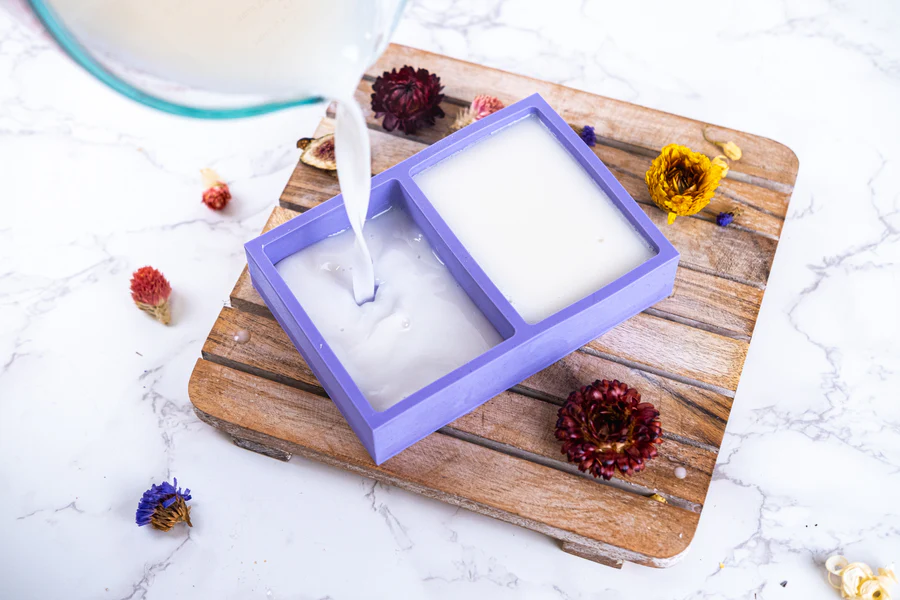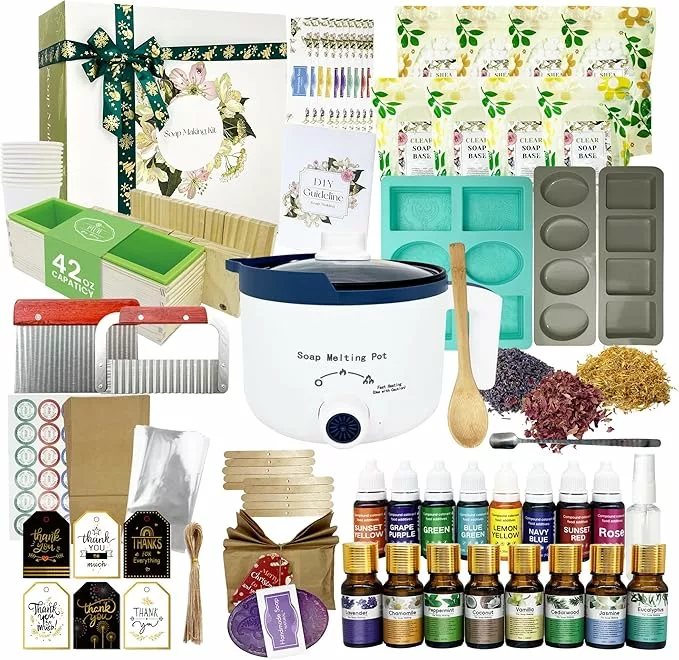
How to Make DIY Melt and Pour Soap: Quick, Easy, and Creative Guide
DIY Melt and Pour Soap Making
DIY melt and pour soap making is the perfect blend of creativity and simplicity. It’s an ideal project for anyone who enjoys hands-on crafts and experimenting with different designs. Whether you’re new to soap making or looking for a quick and satisfying DIY project, this method allows you to create beautiful, customized soaps without the hassle of working with raw ingredients.
With a pre-made soap base that melts easily, you have the freedom to add vibrant colors, unique scents, and interesting textures. This makes it a fantastic option for personal use, thoughtful gifts, or even small business ventures. If you love experimenting with different styles and fragrances, this guide will walk you through the entire process, from preparation to packaging.
As an Amazon Associate, I earn from qualifying purchases.
This post contains affiliate links. If you buy through them, I may earn a commission at no extra cost to you.
Step 1: Gather Your Supplies and Plan Your Design When Making DIY Melt and Pour Soap
Before getting started, it’s essential to have everything ready. A well-prepared workspace not only makes the process smoother but also allows you to focus on the fun, creative part of soap making.
Essential Materials:
- DIY melt and pour soap base – Available in transparent, white, or glycerin formulas.
- Colorants – Liquid soap dyes or mica powders.
- Scented oils – Essential or fragrance oils specifically for soap making.
- Additives – Dried herbs, flower petals, oatmeal, honey, or cosmetic-grade glitter.
- Soap molds – Silicone molds in various shapes and sizes.
- Heat source – Microwave or double boiler.
- Mixing tools – Heat-safe container and a stirring utensil.
When Working With DIY Melt and Pour Soap Plan Your Creative Direction:
- Choose a theme: Seasonal colors, floral blends, or fresh, citrusy scents.
- Select complementary scents: Lavender for relaxation, eucalyptus for a refreshing feel, or vanilla for a comforting aroma.
- Consider texture and appearance: Oatmeal for exfoliation, dried flowers for aesthetics, or shimmer for a touch of luxury.
Having a clear plan before melting your soap base will help you achieve the best results. I often jot down ideas or sketch quick designs to visualize my final product.
Step 2: Melt the Soap Base
Melting your DIY melt and pour soap base correctly ensures a smooth, professional finish. Too much heat can ruin the consistency, so patience is key.
Melting Methods:
- Microwave: Heat in short bursts (10-15 seconds), stirring in between to prevent overheating.
- Double Boiler: Place the soap base in a heatproof bowl over a pot of simmering water. Stir gently until fully melted.
Pro Tips:
- Avoid overheating; too much heat can alter the soap’s texture.
- If using fragile oils or additives, wait until the base has slightly cooled before adding them.
- Stir slowly to avoid bubbles and maintain a smooth consistency.
Taking your time during this step will help prevent air pockets and create a more even pour.
Step 3: Customize with Color, Scent, and Additives
This is where the fun begins! Adding color, fragrance, and texture allows you to personalize your DIY melt and pour soap.
Color and Fragrance:
- Add a few drops of dye or a pinch of mica powder, stirring gently until fully blended.
- Mix in fragrance oil after the color is well incorporated. Start with a few drops and adjust to preference.
- For a marbled effect, swirl two colors together lightly with a toothpick before pouring.
Texture and Extras:
- Dried herbs & flowers: Ensure they are finely ground to avoid rough textures.
- Exfoliants: Oatmeal, coffee grounds, or poppy seeds add gentle scrubbing properties.
- Shimmer & sparkle: A tiny pinch of cosmetic-grade glitter adds a glowing effect.
Carefully blending these elements ensures a uniform, polished final result. Experimenting with different ingredients can lead to unique and stunning designs for your own DIY melt and pour soap.
Step 4: DIY Melt And Pour Soap, Shape, and Set
Pouring requires a steady hand to avoid bubbles and ensure an even texture.
Pouring Tips:
- Slowly pour into molds to reduce air pockets.
- If layering colors, pour in stages and let each layer set slightly before adding the next.
- Tap the mold gently to release any trapped bubbles.
Setting and Cooling:
- Let soaps cool at room temperature for a few hours.
- If needed, refrigerate briefly to speed up the process, but avoid overcooling as it can make unmolding tricky.
- Once fully set, gently remove soaps from their molds and allow them to air out before wrapping.
Patience here ensures a smooth and polished finish, making the soaps easier to handle and store.
Step 5: Finishing Touches and Packaging
Presentation adds an extra special touch, especially if you’re gifting or selling your soaps.
Polishing & Storage:
- Trim any rough edges with a sharp knife.
- Store in a cool, dry place to prevent sweating or melting.
- Let soaps cure slightly to enhance hardness and scent longevity.
Creative Packaging Ideas:
- Wrap in clear cellophane and tie with a ribbon.
- Use fabric pouches or eco-friendly kraft boxes.
- Attach a handwritten tag with ingredients and scent descriptions.
Well-packaged soaps make a great impression and can elevate your DIY projects to a professional level.
Step 6: Troubleshooting & Refining Your Technique
Even with careful preparation, challenges can arise. Here are some common issues and fixes:
- Bubbles in the soap? Tap molds gently and stir the base slowly.
- Uneven color? Add dye gradually and stir thoroughly.
- Additives sinking? Stir in just before pouring.
- Scent fading? Use high-quality, soap-safe fragrance oils and proper measurements.
Keeping a notebook of your recipes and troubleshooting notes can help improve your process over time.
Step 7: Expanding Your Projects
Once you’ve mastered the basics, there are endless possibilities to explore.
Advanced Ideas:
- Layered soaps – Combine different colors and scents for depth.
- Embedded designs – Add small soap shapes within larger bars for unique effects.
- Seasonal collections – Create themed sets for holidays or special occasions.
Staying Consistent:
- Keep a regular production routine.
- Experiment with one new technique at a time.
- Maintain a clean and organized workspace for efficiency.
With time and practice, you’ll develop your own signature style, making each batch of soap a creative success.
Safety Tips for DIY Melt and Pour Soap Making
While melt and pour soap making is a fun and beginner-friendly craft, it’s important to follow a few safety precautions to ensure a smooth and hassle-free experience.
✅ Handle Hot Soap with Care – Melted soap can reach high temperatures, so always use heat-resistant gloves or utensils and wear an apron when handling the mixture. For those with allergies or prone to asthma, wearing a mask is recommended.
✅ Use a Microwave-Safe or Heatproof Container – If melting soap in the microwave, use a container that can withstand heat without warping or cracking.
✅ Avoid Overheating – Soap bases can scorch if overheated, leading to a poor texture and burnt scent. Melt in short intervals and stir frequently.
✅ Work in a Well-Ventilated Area – Some fragrance oils can be strong when heated. Ensure proper airflow, especially when working with essential oils.
✅ Be Mindful of Additives – Some natural ingredients, like citrus oils or certain botanicals, can cause skin irritation. Always test a small batch if trying new additives.
✅ Keep Out of Reach of Children and Pets – While making DIY melt and pour soap is a great family activity, melted soap and fragrance oils should be handled by an adult to avoid accidental burns or spills.
By following these simple precautions, you can safely enjoy the creative process of making beautiful, customized DIY melt and pour soaps.
Final Thoughts and Next Steps
DIY melt and pour soap making is an enjoyable and rewarding craft that blends artistic creativity with practical use. With just a few supplies, you can craft stunning, personalized soaps that make wonderful gifts or a great addition to your self-care routine.
What’s Next?
✅ Choose a theme or scent for your next batch.
✅ Gather supplies and set up a clutter-free workspace.
✅ Start experimenting and enjoy the creative process!
Whether you’re making soaps for yourself, as gifts, or for a small business, this simple yet customizable method allows endless creativity. Give it a try and see where your imagination takes you!
Contact Us
We hope you found this information on DIY melt and pour soap helpful! If you have any questions or need assistance, feel free to reach out. Please note that due to government regulations, you’ll need to sign in and confirm your message. We apologize for any inconvenience.
Author: Rob
Ps. This is the company that taught me how to build this site and 3 others in 6 months, they keep their promises.




This guide makes DIY melt and pour soap making sound so fun and accessible! I love how it emphasizes creativity—there’s so much room for personalization with colors, scents, and textures. It’s great that you can make unique soaps without the hassle of handling raw ingredients. Whether for personal use or gifting, this project seems perfect for anyone looking to get crafty. Plus, it could even turn into a small business venture with some practice!
Hi Zac,
Thanks for your positive comments, and yes it is one of the less complicated crafts available to almost anyone.
Robby